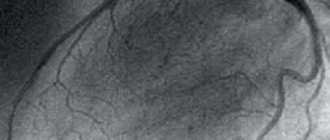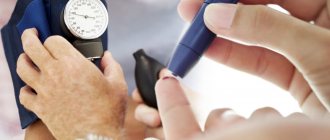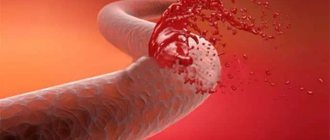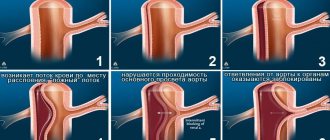Health school for patients with arterial hypertension
Friday, 30 April 2021
ARTERIAL HYPERTENSION: HOW TO RECOGNIZE IT?
Arterial hypertension is a widespread disease in the world. In Russia, over 40% of men and women suffer from arterial hypertension. Mortality from complications of arterial hypertension is increasing. Thus, in Russia, morbidity and mortality from such a formidable complication of arterial hypertension as cerebral stroke remain among the highest in the world. However, our patients' awareness of the symptoms and complications of this disease is not sufficient for its early detection.
Lack of awareness about arterial hypertension leads to an underestimation of the severity of this disease, to low seeking help from doctors at an early stage of the disease, when serious complications can still be avoided. All this together, unfortunately, leads to insufficiently effective treatment: only 17% of women suffering from this disease can normalize blood pressure, and in men this figure is even lower - less than 6%!
Therefore, in order to defeat a disease, it is necessary to have knowledge about the causes of its occurrence, manifestations and ways to combat it.
Increased blood pressure is the main manifestation of arterial hypertension. A one-time increase in blood pressure after emotional stress, heavy physical work and some other influences does not mean that arterial hypertension has developed. Only with a stable and prolonged increase in blood pressure do doctors talk about arterial hypertension. Arterial hypertension is a chronic disease.
Blood pressure is characterized by two indicators: upper - systolic pressure is determined by the force with which, when the heart contracts, blood presses on the walls of large arteries. Lower - diastolic blood pressure corresponds to the relaxation of the heart, when the pressure of blood inside the arteries decreases.
The presence of arterial hypertension is indicated by a blood pressure level of more than 140\90 mmHg.
These limits apply to adults of both sexes.
In the majority of patients (90-95%), arterial hypertension is the primary disease, which in our country is called “hypertension”, and abroad is called “essential hypertension”. In hypertension, an increase in blood pressure is not associated with primary damage to any organs. An important role in the development of hypertension is played by overstrain of the main nervous processes. Hypertension is a chronic disease. A prolonged increase in blood pressure as a result of complex changes in the body leads to disruption of the regulation of the heart and an increase in the thickness of the smooth muscles of blood vessels, their spasm, which in turn leads to disruption of the nutrition of such important organs as the brain, heart and kidneys.
Based on the level of blood pressure (BP), there are 3 degrees of hypertension:
· 1st degree
(mild hypertension) - blood pressure 140-159 / 90-99 mmHg. Art.
· 2nd degree
(moderate) - blood pressure 160-179 / 100-109 mm. Hg Art.
· 3rd degree
(severe) - blood pressure equal to or greater than 180/110 mm. Hg Art.
Stage 1 hypertension, also called the “mild” form, is by no means harmless. This form of the disease is the most common: it affects about 70% of patients, and it is in such patients that the risk of developing cerebral strokes increases by 2-4 times compared to the risk in people with normal blood pressure.
Therefore, the attitude towards the 1st and 2nd degrees of hypertension should be vigilant and no less serious than towards the 3rd degree.
Often, with grades 1 and 2 hypertension, patients underestimate the severity of the disease and do not know what subjective sensations they should pay attention to. The disease gradually progresses. At first, there is only a tendency to increase blood pressure, the increase may be unstable, but over time, if the disease is not treated, blood pressure becomes very stable and causes severe disorders of the internal organs.
As already mentioned, the most common cause of arterial hypertension is hypertension. However, in some patients arterial hypertension is a consequence of diseases of a number of organs, i.e. increased blood pressure is a secondary manifestation against the background of initial damage to the kidneys (for example, with their inflammation), arteries supplying blood to the kidneys (if they are narrowed), as well as with a disorder of the functions of certain endocrine organs (adrenal glands, thyroid gland).
This form of arterial hypertension is called symptomatic or secondary. Identifying the true cause of the disease and proper treatment can in such cases lead to complete recovery and normalization of blood pressure.
To detect arterial hypertension in a timely manner, you need to know what its manifestations are, or, as doctors say, symptoms.
The most typical manifestations of high blood pressure are those of the central nervous system and the heart.
Frequent neurotic symptoms are headache, fatigue, nervousness, excitability, and poor sleep.
With a long course of the disease, changes in the heart occur, which are manifested by attacks of pain in the heart area, rapid heartbeat, disturbances in the rhythm of the heart, and shortness of breath. Heart failure develops.
It should also be remembered that when blood pressure increases, nosebleeds may occur, so if they recur, be sure to measure your blood pressure and consult a doctor.
Headache, usually in the occipital region, often accompanies high blood pressure. In some cases, the severity of the headache increases as blood pressure rises. However, it also happens that patients, even with high blood pressure, do not feel a headache and feel well, which makes it difficult to identify the disease. This depends on the characteristics of a person’s psychological make-up and on gradual adaptation to the disease.
Therefore, you should be attentive to your feelings, but you cannot rely on them alone: regular visits to a doctor and monitoring blood pressure will allow you to identify arterial hypertension in time.
ARTERIAL HYPERTENSION: WHAT PROMOTES ITS DEVELOPMENT?
Currently, numerous circumstances and influences are known that, to one degree or another, determine the level of human health and the state of his cardiovascular system.
Doctors often talk about “risk factors” when talking with patients. These are those features of the body, life and behavior of a person that can contribute to the development of arterial hypertension or other cardiovascular diseases.
Every person should be aware of the most serious risk factors, since he can influence some of them independently or with the help of a doctor, and thereby reduce the risk of arterial hypertension and its complications.
Let's discuss some of the most important risk factors for developing arterial hypertension.
Heredity, i.e. The presence of arterial hypertension in parents can contribute to the development of arterial hypertension in children, therefore, the disease in the family should always be reported to the attending physician. However, if parents suffer from arterial hypertension, this does not mean that their children will necessarily also develop arterial hypertension. Hereditary predisposition may manifest itself under the influence of other environmental factors.
If your family suffers from cardiovascular diseases, it is important to pay attention to the age at which they appeared: these diseases have an adverse effect (as risk factors) before the age of 65 years in women and under 55 years in men.
A person’s reaction to psycho-emotional stress and his lifestyle also influence the development of arterial hypertension.
Thus, long-term chronic stress (overstrain of the nervous system), negative emotions associated with troubles at work or at home - all this can contribute to the development of arterial hypertension. It is especially unfavorable if the stressful situation is repeated frequently and over a long period of time. In people predisposed to the development of arterial hypertension, repeated stress-induced increases in blood pressure (BP) can develop into a chronic disease - hypertension.
Excess weight of a person contributes to increased blood pressure: there is a direct connection between the patient’s weight and blood pressure levels. The risk of developing arterial hypertension increases 2–6 times in obese individuals! An increase in weight of 10 kg leads to an increase in blood pressure by 2 - 3 mm Hg!
Obese people often have elevated cholesterol levels in their blood. It is necessary for the normal functioning of the body, but when the level of total cholesterol increases by more than 5 mmol/liter, its excess can be deposited in the walls of blood vessels, and a level in the blood of more than 6.5 mmol/l leads to adverse consequences.
People who lead a sedentary lifestyle are 20-50% more likely to develop arterial hypertension than active people who engage in physical training.
A serious risk factor is smoking. Smoking is the most common bad habit in Russia among men, among whom 63% smoke. Among young women, every fourth smokes. The cause of death of every third smoker is heart and vascular disease!
Taste habits should also be taken into account.
Numerous scientific studies have found that excessive consumption of table salt leads to increased blood pressure. Thus, academician V.V. Parin cited the dependence of the height of blood pressure on the salt consumed by the indigenous inhabitants of Greenland and Japan: among Greenlanders, who consumed up to 4 g of salt per day, blood pressure was within normal limits, and among the Japanese, whose diet included up to 15 g of salt Blood pressure was 170/100 mm Hg. Art.
These compelling observations make you think and draw conclusions!
An increase in blood pressure or its significant fluctuations equally affects the condition of human organs, causing serious changes in them. The most vulnerable organs (target organs) in patients with arterial hypertension are the heart, brain, kidneys and blood vessels. The vulnerability of these organs varies from patient to patient: in some, cerebral circulation is more affected, in others, the blood vessels of the heart are more affected.
The severity of arterial hypertension depends on the damage to these organs. If you do not control your blood pressure levels, do not pay attention to elevated blood pressure levels, and do not follow your doctor’s recommendations to lower blood pressure, serious complications may arise from the heart, brain, blood vessels of the eyes and kidneys.
Heart:
overstrain of the heart muscle against the background of arterial hypertension can lead to an increase in its mass - hypertrophy, which increases the risk of heart rhythm disturbances. The blood supply to the heart muscle deteriorates, cholesterol plaques are deposited in the heart (coronary) vessels, their lumen becomes narrower, coronary heart disease develops, which is manifested by attacks of angina, and myocardial infarction may develop. Weakening of the heart muscle leads to the development of heart failure.
Brain:
high arterial hypertension (BP 189/105 mm Hg and above) or hypertensive crises can lead to acute cerebrovascular accidents - cerebral hemorrhage.
Eyes:
Hemorrhages may also occur in the fundus of the eye, which can lead to loss of vision.
Kidneys:
With prolonged arterial hypertension, renal function decreases and renal failure develops.
This is just a brief listing of the main complications of arterial hypertension, which attacks vital organs.
This prospect is frightening. That is why the patient must know how insidious arterial hypertension is, must understand its consequences, and armed with knowledge can and must fight it, and doctors will help to minimize those formidable complications that we have talked about.
ARTERIAL HYPERTENSION: HOW TO CORRECTLY MEASURE BLOOD PRESSURE LEVEL?
You have already become familiar with the causes of arterial hypertension and know what the main symptoms of this disease are.
It should be borne in mind that each patient may experience arterial hypertension differently. Thus, in some cases, so-called “white coat” hypertension is observed, i.e., elevated blood pressure numbers are detected only when blood pressure (BP) is measured by medical workers, and at home the blood pressure level does not exceed normal values. Such fluctuations in blood pressure cannot be ignored, since in the future they can contribute to the development of complications.
In most patients, blood pressure remains stably elevated - “stable” (persistent) hypertension develops.
Some patients may experience hypertensive crises - a sharp increase in blood pressure, which may be accompanied by increased headache, nausea, sometimes dizziness, and palpitations. In such cases, emergency care and medical supervision are necessary.
It is very important for all patients suffering from arterial hypertension to monitor their blood pressure levels, contact medical professionals in a timely manner, or learn to measure it themselves.
Monitoring blood pressure levels is necessary for the timely detection of arterial hypertension, blood pressure fluctuations, hypertensive crises, as well as for monitoring the correctness of treatment.
Reliable results when measuring blood pressure can be obtained by observing basic rules in relation not only to the device for measuring blood pressure, but also to the patient himself and his environment.
Before measuring blood pressure, the patient must sit for at least 5 minutes. in a relaxed state in a comfortable chair with support on its back, legs should be relaxed and not crossed. The patient should not wear tight, constricting clothing. It is not recommended to talk while measuring blood pressure. Blood pressure should be measured sequentially 2-3 times at intervals of 1-2 minutes after the air is completely deflated from the cuff. The average of two or three measurements taken on one arm is more accurate in reflecting blood pressure than a single measurement.
The arm with the cuff placed on the shoulder should be bare and motionless; it should be placed on a table located next to the chair. The middle of the cuff placed on the shoulder should be at the level of the patient's heart. Deviation from this position may lead to false blood pressure measurements (overestimation of blood pressure when the cuff is positioned below the heart level and underestimation of blood pressure when the cuff is positioned above the heart level). It is advisable to measure blood pressure 2 times a day at the same time (morning and evening) no less than 30 minutes later. after physical exertion, smoking, eating, drinking tea or coffee.
It is advisable to record the results of blood pressure measurements in a personal diary (you can use a regular notebook for this) in order to then coordinate treatment with your doctor.
The patient's environment when measuring blood pressure should be quiet and calm. The room should be warm (about 21 C), since low air temperature can cause an increase in blood pressure.
For patients suffering from arterial hypertension, it is advisable to purchase a device for measuring blood pressure (tonometer) and be able to independently monitor its level. When measuring blood pressure at home, you can estimate its value on different days in everyday life. Blood pressure can be monitored using devices with a “manual” measurement method. It is based on the method of listening to tones on the ulnar vessels (this method was proposed by N.S. Korotkov and is the most accurate). At home, semi-automatic or automatic blood pressure monitors are convenient. An important factor influencing the quality of blood pressure self-monitoring is the use of devices that meet accuracy standards. You should not purchase tonometers without documents confirming their compliance with accepted standards.
Currently, automatic devices for daily recording of blood pressure during periods of wakefulness and sleep are widely used in cardiology clinics and dispensaries. Data from 24-hour blood pressure monitoring more accurately reflect the relationship between blood pressure and changes in vital organs compared to one-time blood pressure measurements.
The use of this method makes it possible to identify the previously mentioned “white coat” hypertension at home, as well as record changes and fluctuations in blood pressure not only during the day, but also at night. Daily blood pressure monitoring helps doctors especially accurately assess the effectiveness of treatment for arterial hypertension.
A patient suffering from arterial hypertension must be aware of how this disease progresses in him, must be able to properly control blood pressure levels and, if necessary, consult a doctor in a timely manner.
METHODS FOR PREVENTION OF ARTERIAL HYPERTENSION.
It is very important for patients suffering from arterial hypertension to promptly consult their doctor to decide on the correct choice of medication. However, it should be remembered that the success of treatment depends not only on the doctor. Patients often wonder whether there are methods for preventing arterial hypertension; can the patient himself actively participate in the treatment process?
In the prevention of arterial hypertension, an important role in some cases is given to ways to overcome arterial hypertension without the use of drugs, that is, non-drug treatment methods.
Firstly, such approaches are recommended for the prevention of increased blood pressure, especially in cases where, when measured, the blood pressure level is just beginning to exceed the threshold of normal values (130/85 mm Hg), that is, when hypertension has not yet fully manifested itself. If, due to an accidental measurement or overwork after a busy day, blood pressure reaches 130-139/85-89 mm Hg. Art. is a good reason to pay attention to yourself and think about what features of the current lifestyle and ingrained habits can lead to the development of hypertension in the future.
The use of non-drug approaches is especially important for individuals with existing concomitant risk factors for the development of cardiovascular complications. This, as we already well know, is the age and gender of the patients: men over 55 years of age and women over 65 years of age, high cholesterol levels in the blood, diabetes mellitus, smoking, obesity, and a sedentary lifestyle.
In addition, it should be remembered that non-drug methods can and should be used not only to prevent the development of arterial hypertension: they are recommended for all patients, regardless of the severity of arterial hypertension and concomitant drug treatment, since they are aimed not only at preventing the development of arterial hypertension , but also to enhance the effect of medications already taken and reduce the number of medications taken.
The answer to the question of what range of measures are covered by non-drug ways to overcome arterial hypertension lies in the concept of a person’s “lifestyle,” which includes lifestyle, attitude towards oneself and others, established habits and addictions.
Compliance with recommendations for a healthy lifestyle requires the patient to reconsider and overcome the usual daily routine and show willpower. First of all, this is a change in the quality of life: you need to force yourself to give up a sedentary lifestyle and bad habits. Patients with high blood pressure are not recommended to work night shifts, noisy environments, work associated with frequent business trips, or psycho-emotional overload. The correct daily routine includes reducing the time spent working with the computer, avoiding prolonged viewing of TV shows, and getting a good night's sleep.
An important role is played by increasing physical activity. Regular physical training is useful both for preventing high blood pressure and for treating arterial hypertension. In untrained individuals with normal blood pressure who lead a sedentary lifestyle, the risk of developing arterial hypertension is 20-50% higher than in those who lead a more active lifestyle. Meanwhile, physical training, even if it is moderate, can reduce blood pressure by 5-10 mmHg. Art. Low-intensity aerobic exercise helps lower blood pressure. Such soft loads as fast walking, swimming for 30-45 minutes. 3-5 times a week, more physiological than intense forms of exercise, such as running. So-called static isometric loads, such as exercises with a barbell, are not recommended. It is important to know that carrying and lifting heavy objects can increase blood pressure.
You should know that the appearance of shortness of breath, pain in the chest, in the heart area, or interruptions in heart function during physical training requires immediate cessation of exercise and consultation with a doctor. The method of physical activity and increasing physical activity must be agreed upon with the doctor and physical therapy methodologist.
In addition to physical activity, dietary nutrition plays an important role in improving lifestyle. A necessary condition for proper nutrition is regular meals, at least 4 times a day. Don't overeat before bed. You should have dinner no later than 2 hours before bedtime. A late dinner brings the digestive glands into an active state, blood moves to the abdominal organs, which can disrupt a good night's rest and lead to breathing problems, heavy dreams, and an excess of unspent calories leads to obesity. As a rule, overweight people more often suffer from arterial hypertension, atherosclerosis of the blood vessels of the heart and brain, they can develop diabetes mellitus quite early, the spine, joints of the arms and legs suffer.
Fat deposition in the abdominal area (the human figure resembles an apple) is especially unfavorable for the body: this type of obesity in itself is a risk factor. Weight loss helps lower blood pressure in most patients with hypertension whose body weight is more than 10% higher than normal. Persons with arterial hypertension who are overweight are recommended to consume a sufficient amount of vegetables (500-600 g per day) and fruits - 300 g per day (with the exception of bananas, grapes, figs), including low-fat cottage cheese, lean meats and fish. With high blood pressure and a tendency to edema, try to limit fluid intake (water, tea, soup, fruit juices) to 1-1.2 liters per day. It is recommended to drink only fruit juices and waters that are made without added sugar.
Eliminate products made from premium flour from your diet. Significantly limit sweets (sweets, cakes, ice cream) - these products turn into fats in the body. Limit animal fats and cook food in vegetable oil. It is advisable to replace fatty varieties of beef and pork in the diet with poultry (chicken, turkey), removing fat and skin during processing (they contain a lot of cholesterol). Include seafood in your diet more often, increase your consumption of fish, especially sea fish.
Particular attention should be paid to dietary restrictions on table salt. It has been established that reducing salt (sodium chloride) intake from 10 to 4.5 g/day (flat teaspoon) leads to a decrease in systolic (upper) blood pressure by 4-5 mm Hg. Overweight patients and the elderly are especially sensitive to reducing salt intake: limiting salt to 2 g/day leads to a significant reduction in the number of blood pressure-lowering pills that these patients previously took. In order to limit salt, it is recommended to cook food without salt (2-3 grams are contained in food products), and the finished dish can be slightly salted. You can also use low-sodium salt, which is available in pharmacies and health stores.
When setting a goal to modify your diet, you should adhere to the following important principle: try to eat more fruits and vegetables rich in potassium (dried fruits are rich in them) and magnesium (bran, buckwheat and oatmeal, nuts, beans).
It should be remembered that changing the nature of nutrition should become permanent: short-term dietary measures will not lead to the desired result.
The combination of diet with regular physical training is an effective way to prevent arterial hypertension and an important part of the treatment of patients suffering from hypertension, especially in the initial stages of the disease.
Improving your lifestyle is also associated with giving up some habits, called “bad” ones.
First of all, smoking, it 2-3 times increases the risk of developing coronary heart disease and cerebral stroke in people with arterial hypertension. Quitting smoking is one of the effective ways to reduce risk in patients with hypertension, an integral part of measures to prevent cardiovascular complications.
Regular excessive consumption of alcohol leads to increased blood pressure, especially in people for whom this bad habit is the norm. However, in recent years, scientists have found that moderate alcohol consumption, especially in combination with reducing excess weight, reduces the risk of cardiovascular complications. It has been shown that countries where natural wine is traditionally consumed (for example, France) have a low mortality rate from heart and vascular diseases. According to scientists, it is acceptable to drink alcohol in amounts up to 20-30 g of pure ethanol per day for men (which corresponds to 50-60 ml of vodka, 200-250 ml of dry wine, 500-600 ml of beer), and for women - half of this dose . In healthy people, these doses prevent the development of atherosclerosis and help normalize blood pressure. But it should be kept in mind that tolerance to even moderate amounts of alcohol varies from person to person and these recommendations are not suitable for everyone. It is important to remember that exceeding these amounts is fraught with serious consequences, especially for those who suffer from hypertension and related complications. Those being treated for hypertension should also remember that alcohol and many medications that lower blood pressure are incompatible.
For those who have seriously thought about their lifestyle and want to change it, it is important to know that when combining measures such as weight loss, regular physical exercise, limiting salt and alcohol consumption, their effectiveness increases and the chances of not getting hypertension and avoid its dangerous complications.
However, when starting a set of non-drug methods for the prevention and treatment of arterial hypertension, you must clearly understand that your efforts should not be short-term measures. The effect can only be achieved with regular and long-term implementation of these methods.
ARTERIAL HYPERTENSION: WHEN AND WHOM SHOULD MEDICATIONS COME TO HELP?
Treatment of patients with high blood pressure is aimed at reducing it and maintaining it at a level less than 140/90 mmHg. Art., to improve well-being and increase performance, and most importantly - to reduce the likelihood of developing serious complications: cerebral stroke and myocardial infarction.
The development of serious complications in patients with high blood pressure depends not only on its level, but also on the presence of risk factors, damage to target organs (we talked about this earlier), as well as on some concomitant diseases: cerebral vessels, heart diseases (angina, heart failure), kidneys (especially kidney damage in diabetes), the severity of damage to the vessels supplying the eyes (fundus), as well as the arteries of the legs.
It is important to understand that only a doctor can correctly assess when and to whom medications are indicated in order to avoid cardiovascular complications in the future. The doctor relies not only on his own experience, but also on recommendations developed by experts, which take into account the results of treatment and long-term observation of hundreds and even thousands of patients with arterial hypertension. According to these recommendations, not only the level of blood pressure is taken into account, but also the above-mentioned concomitant diseases, which together makes it possible to judge the level of risk of stroke or myocardial infarction in the next 10 years. The risk level can be low, medium or high.
However, the threat of complications can be prevented. The common efforts of the patient and the doctor in the fight against this disease are not in vain and are not hopeless, as evidenced by numerous international studies on measures to prevent the possible risk of complications in arterial hypertension.
Modern medications come to the rescue.
The decision on treatment tactics, that is, on the use of only non-drug measures (lifestyle changes) or the need to add medications and, most importantly, the choice of the medicine itself, is a serious decision that only a doctor can make.
If the risk of vascular complications is high, medications that lower blood pressure are immediately prescribed. If necessary, medications are prescribed for concomitant diseases, which also determine the prognosis. It is especially important to prescribe medications that reduce high blood sugar and excess fat in the blood (in cases where these indicators are elevated); some patients are prescribed medications to normalize blood clotting and avoid thrombosis.
For patients with a low risk of complications, the doctor recommends observation (from 3 to 12 months) before deciding on the need for drug therapy.
As you can see, the approach to each patient is individual and only the experience and knowledge of the doctor allows you to make the right decision.
It should be remembered that taking medications should not lead to a rapid and sharp decrease in blood pressure. In patients who have been suffering from arterial hypertension for a long time, a sharp decrease in blood pressure (by 25 - 30% or more from the initial level) with concomitant cerebral atherosclerosis, which is detected in 1/3 of patients with arterial hypertension, can worsen the blood supply to this vital organ, which is serious will affect the well-being and condition of the patient. This is especially important to consider for patients who have suffered a stroke or myocardial infarction.
When starting treatment with a new drug for a given patient, doctors recommend using low doses of these drugs in order to reduce some of the adverse effects. Only if the drug is well tolerated and blood pressure is not sufficiently reduced, the doctor may increase the dose of the drug.
The question often arises: take one medicine at the maximum dose or add a second drug? To date, it has been established that a combination of low or medium doses of two (and, if necessary, three) drugs with different mechanisms of action is more effective. This approach leads to a greater reduction in blood pressure and better tolerability of drugs, since taking lower doses of each drug can reduce some of its undesirable effects.
For many years, to treat hypertension, patients were prescribed medications that had to be taken 3 to 4 times a day, since their duration of action usually did not exceed four hours. When the drug wore off, blood pressure could rise again if the patient forgot to take the next dose of the drug. It is important to know that short-acting drugs (for example, clonidine), which reduce blood pressure after 10-15 minutes, but do not maintain the achieved effect for a long time, are good as an “ambulance” for a hypertensive crisis, but are not suitable for long-term therapy.
In recent years, new long-acting drugs have been developed that provide adequate blood pressure reduction within 24 hours when taken once daily. Such drugs make it possible to avoid changes in blood pressure during the day due to a mild and long-lasting effect, and make it easier for forgetful and busy patients to comply with the medication regimen.
The packaging of long-acting drugs usually has the symbols ER, SR, LP, and such capsules, dragees or coated tablets cannot be broken (in the absence of a special notch) and chewed, but should be swallowed whole, otherwise the effectiveness of the drug will be impaired. It is recommended to take them at the same time: in the morning or in the evening, the time of administration is determined by the doctor.
Tomatoes clean vessels
And the University of Cambridge (England) pleased with the news about the unexpected side of tomatoes. It turns out that the substance lycopene, which is part of their composition, has an amazingly beneficial effect on the endothelium - the inner walls of blood vessels. The benefits of lycopene as an antioxidant have been discussed more than once, but now it has become clear that it also cleanses blood vessels from the inside, improving their permeability by 53%. Of course, this is if the vessels were in poor condition; in healthy ones, it simply maintains the norm. Conveniently, lycopene, unlike many useful substances, is not afraid of heat, so tomatoes can be stewed and baked with a clear conscience.









